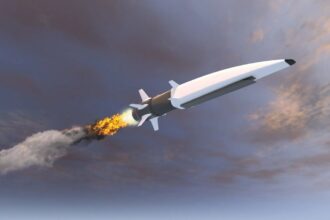China has claimed a breakthrough in military technology. According to a new study by Chinese military researchers, the country now can launch hypersonic missiles from space.
These missiles, called re-entry glide vehicles (RGVs), can travel at speeds of up to Mach 20, which is around 13,000 miles per hour. At this speed, the missiles could strike anywhere in the world in under 30 minutes.
The study was published in the Chinese academic journal Acta Aeronautica et Astronautica Sinica. It was led by Professor Guo Yang from the People’s Liberation Army Rocket Force (PLARF).
The researchers say these weapons can be launched from satellites, ground stations, or other platforms. Their high speed and unpredictable movement make them difficult to detect and intercept using current early-warning systems.
The researchers say that RGVs are designed with a high lift-to-drag ratio. This helps them glide through the atmosphere in a smooth but rapid way. Because they do not follow a traditional path like a regular missile, they are much harder to track.
These weapons are especially dangerous because they can compress the time an enemy has to respond. In military terms, this gives the attacker a big advantage by reducing the defender’s reaction window.
Hypersonic glide vehicles like RGVs are different from standard ballistic missiles. While ballistic missiles travel in a fixed path, hypersonic glide vehicles can change direction while flying. This makes them harder to shoot down.
The study mentions that Chinese RGVs can move in near-space regions and perform large, fast changes in direction. These movements are made possible by the vehicle’s special aerodynamic design, which allows them to glide smoothly at very high speeds.
However, the technology still has problems. The Chinese researchers admit that the system is not perfect yet. One major issue is the strong infrared signature produced by the missile. This heat trail can make it easier for other countries to detect the missile from far away.
Also, during the final stage of its flight, the missile may have limited communication abilities. This can make it harder to control or guide the missile accurately toward its target. In addition, its ability to maneuver at the end of its flight may be limited due to low overload resistance.
Despite these issues, China’s progress in hypersonic weapons is seen as a serious development in global defense. In the past, some experts called China’s space-based hypersonic weapons “science fiction.” But now, more researchers and defense analysts believe these weapons are real and could soon be operational.
As reported by SCMP, In 2021, the Financial Times reported that China had tested hypersonic weapons launched from near-Earth orbit. At that time, some critics thought these reports were exaggerated. But this new study supports those earlier claims.
It also suggests that China’s military is working hard to create more advanced missile systems that are not only fast but also harder to detect and stop.
The study comes at a time when other countries are also pushing forward with their own hypersonic programs. The United States and the United Kingdom recently completed 233 tests of hypersonic engines. These tests are part of a joint project called Team Hypersonics, which is expected to produce a new hypersonic cruise missile by 2030.
The engine that was tested can breathe air, which gives it more range than regular rockets. The tests showed that the engine works across a wide range of speeds, from supersonic to hypersonic. This means it is strong enough for future weapons and can be improved even more over time.
The UK Ministry of Defence said the goal is to give the armed forces a big advantage in future conflicts. These new hypersonic missiles could travel farther and faster than older models, making them more powerful on the battlefield. The collaboration between the U.S. and UK is also seen as a way to balance China’s growing military technology.











